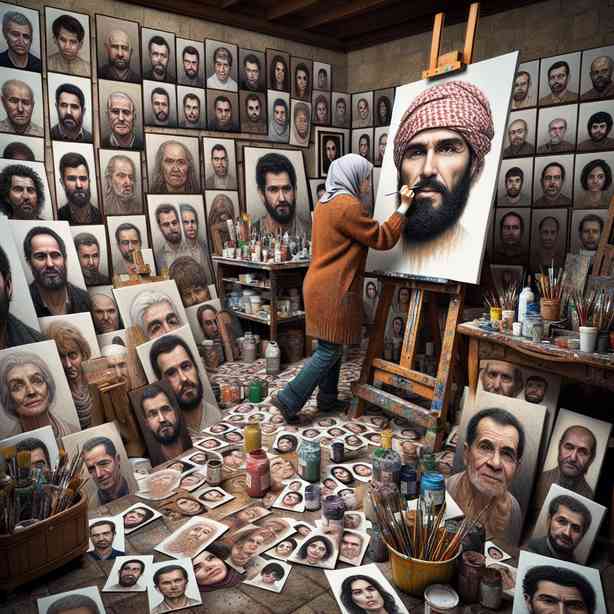
When You Can’t Stop Painting Faces
Art is a medium of expression that transcends time and culture, serving as a reflection of the human experience. Among the many forms of artistic expression, painting, particularly the portrayal of faces, holds a unique significance. The face is often considered the window to the soul, offering insight into emotions, identity, and culture. When it comes to painting, there is a compelling urge within many artists to capture the essence of humanity through faces. This article delves into the reasons behind this fascination, the techniques involved, the emotional connection to the subject, and the impact of face painting on both the artist and the viewer.
The human face is remarkable in its ability to convey a vast array of emotions and stories. Each line, wrinkle, and expression tells a story, making it a subject that artists feel compelled to explore. The quest to capture the subtleties of expression can be both challenging and rewarding. For many artists, this challenge becomes a relentless pursuit that can feel almost obsessive. The desire to depict a fleeting moment—an expression of joy, sadness, or contemplation—can drive an artist to paint faces endlessly. Every brushstroke can evoke an emotion, making the process an intimate dialogue between the artist and their subject.
One of the primary reasons artists find themselves painting faces repeatedly is the complexity and depth of human emotion. Artists often find that the face is an intricate canvas that reflects not only personal experiences but also universal themes. This broad spectrum of emotion allows for a diverse range of creative interpretations, making each painting a unique exploration of the human condition. The challenge of capturing these subtleties can lead to an artistic journey that seems infinite. Artists can spend years refining their ability to portray emotions effectively, always striving for that perfect likeness or expression that resonates deeply with viewers.
In addition to emotion, cultural significance plays a vital role in face painting. Different cultures have unique ways of expressing identity and emotion through facial features. Artists often draw inspiration from their cultural backgrounds, incorporating elements that reflect their heritage or the experiences of others. This cultural lens adds another layer of meaning to the work, allowing for more profound conversations about identity, representation, and the complexities of the human experience. By immersing themselves in these cultural exchanges, artists can expand their understanding and appreciation of diversity, enriching their artwork as well as their personal development.
The technical aspect of painting faces is equally intriguing. Artists often develop specific techniques to capture the nuances of skin tone, texture, and light. Mastery in color theory becomes essential to convey shadows and highlights effectively, giving the face depth and dimension. Whether using oil, acrylic, or watercolor, each medium presents unique characteristics that can alter the final outcome. Painters must experiment with various styles, brush techniques, and tools to discover the best way to bring their vision to life. This process of experimentation can be both exhilarating and frustrating, leading the artist to continue refining their skills in pursuit of perfection.
Moreover, the act of painting faces can serve therapeutic purposes. Many artists find solace in painting, using it as a means to process their emotions or experiences. This therapeutic quality can transform the creative process into a refuge from the chaos of everyday life. By immersing themselves fully in their artwork, artists find a meditative state where they can navigate their feelings and thoughts. This deep connection to their work can often manifest in the emotional weight of the faces they paint, as each piece reflects a part of the artist’s inner world.
As viewers, the impact of face paintings can be profound. They invite us to connect with the subject on a deeper level, provoking thought and evoking emotion. A painted face can speak volumes, conveying stories that transcend language. Viewers may find themselves relating to the expressions portrayed, reflecting on their thoughts and feelings. The connection formed through art can lead to a greater understanding of ourselves and others, fostering empathy and compassion. This is particularly true in today’s world, where we often find ourselves separated by boundaries yet yearn for connection.
Whether viewed in galleries, homes, or even online spaces, the importance of face paintings in the art world cannot be overstated. They serve as a bridge between the artist and the viewer, enabling a unique form of communication that bypasses traditional methods. The rich tapestry of emotions encapsulated in a painted face creates a lasting impression that lingers long after one has moved on to the next piece of art. The ability to evoke such reactions is what keeps artists painting faces, fueling their passion and dedication to the craft.
In conclusion, the obsession with painting faces stems from various factors, including the complexity of human emotion, cultural significance, technical mastery, therapeutic value, and the profound connection between the artist and viewer. Each painted face tells a story, reflecting not just the individual but also our shared humanity. For many artists, the journey of painting faces is never truly complete. Each canvas presents an opportunity to explore, experiment, and evolve. Whether you are an artist, a lover of art, or someone seeking deeper connections through creativity, the world of face painting offers an invaluable window into emotions, culture, and the myriad experiences that define our existence. The face remains a powerful subject in art, and for those who can’t stop painting them, it is a lifelong journey filled with meaning, understanding, and beauty.


